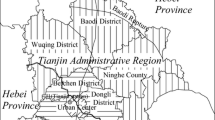Abstract
Like other large-scale development projects, the design, construction, and utilization of subway projects have several positive and negative environmental consequences. In this study, geological hazards in the construction phase of Ahvaz Subway Line 1identified and localized. The environmental impacts also were assessed in the surface and subsurface sections. During the surface evaluation, after providing and preparing the required information layers, AHP and TOPSIS methods were used to model the environmental effects in the subway route. During the subsurface evaluation, the subsidence, liquefaction, soil corrosion, and RQD characteristics were examined separately in a vertical section. The results showed that Stations 1, 2, 11, and 12 had the most significant potential for environmental hazards at the surface section. Assessing the subsurface conditions showed that due to the type of alluvial material and lithology and water table, subsidence was possible in a subway route. Due to the region's seismic conditions, seismic stresses can cause soil displacement and tunnel collapse along the subway route, especially during the construction phase. The soil chemical test results showed that soils in the subway route had moderate to severe corrosion potential.


















Similar content being viewed by others
References
Burrough PA (1989) Fuzzy mathematical methods for soil survey and land evaluation. J Soil Sci 40:477–492
Chu BL, Hsu SC, Chang YL, Lin YS (2007) Mechanical behavior of a twin-tunnel in multi-layered formations. Tunn Undergr Space Technol 22(3):351–362
Coch NK (1995) Geohazards natural and human. Prentice Hall, New Jersey, p 481
Falcon NL (1974) Southern Iran: Zagros mountains. Geol Soc London, Spl Publ 4:199–211
Hashash YMA, Hook JJ, Schmidt B, Yao JI (2001) Seismic design and analysis of underground structures. Tunn Undergr Space Technol 16:247–293
Hashemi M, Nikoudel MR, Moghaddas NH, Khamehchiyan M (2014) Engineering geological conditions of the Holocene sediments of Anzali area, South Caspian Coast, North Iran. Ara J Geosci 7(6):2339–2352
Hunt RE (1984) Geotechnical engineering investigation manual. McGraw hill Book Company, New York, p 983
Jancsecz S, Krause R, Langmaack L (1999) Advantages of soil conditioning in shield tunneling, experiences of LRTS Izmir. In: Alten T (Ed), Proceedings of the World Tunnel Congress '99
Jie YU (2014) Hazard of sesmic liquefaction for metro tunnel structural engineering and countermeasures. J Railw Eng Soc 31(2):115–118
Moradi M, Bazyar MH, Mohammadi Z (2012) GIS-based landslide susceptibilty mapping by AHP method, a case study, Denat City, Iran. J Basic Appl Sci Res 2(7):6715–6723
Samadi L, Mehrabi B (2009) Shallow subsurface geology and Vs characterstics o sedimentary units throughout Rasht City, Iran. Ann Geophys 52(2):149–166
Sherkati S, Letouzey J (2004) Variation of structural style and basin evolution in the central Zagros (Izeh zone and Dezful embayment). Iran Mar Pet Geol 21(5):535–545
Unutmaz B (2014) liquefaction potential of soils around circular double tunnel. Bullet Earthq Eng 14(2):391–411
Acknowledgements
Authors thank Khorramshahr University of Marine Science and Technology for their help and financial support.
Author information
Authors and Affiliations
Corresponding author
Additional information
Editorial Responsibility: Samareh Mirkia.
Rights and permissions
About this article
Cite this article
Lotfeali Ayeneh, A., Amanipoor, H., Battaleb-Looie, S. et al. Evaluation of geological hazard of the subway (case study: Ahvaz subway, southwest of Iran). Int. J. Environ. Sci. Technol. 19, 3061–3074 (2022). https://doi.org/10.1007/s13762-021-03427-7
Received:
Revised:
Accepted:
Published:
Issue Date:
DOI: https://doi.org/10.1007/s13762-021-03427-7




